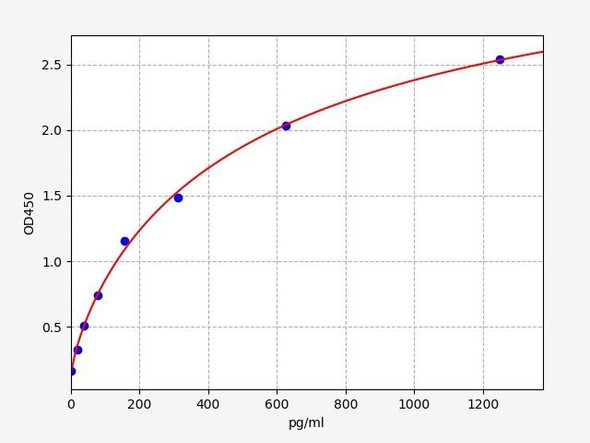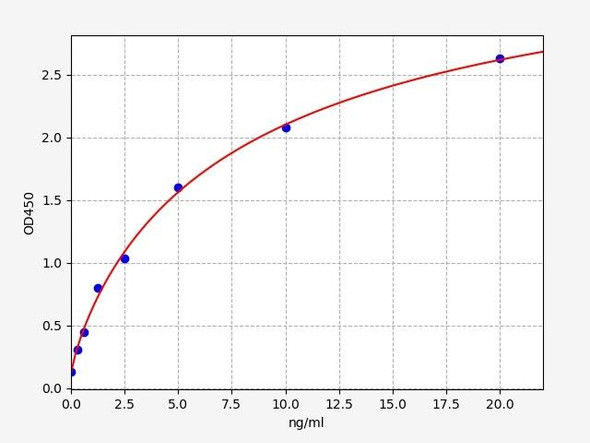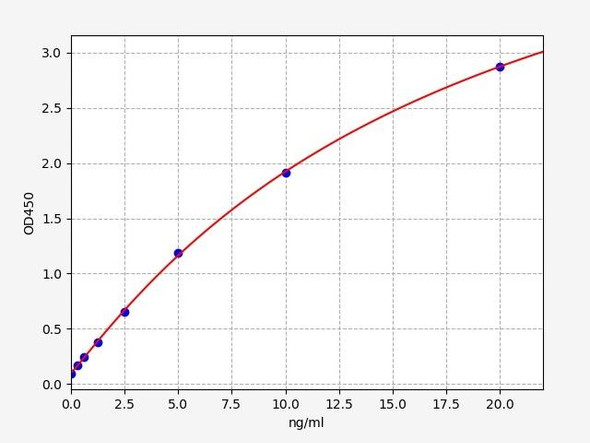Rat Connexin 43 / GJA1 ELISA Kit
- SKU:
- RTFI00709
- Product Type:
- ELISA Kit
- Size:
- 96 Assays
- Uniprot:
- P08050
- Sensitivity:
- 0.094ng/ml
- Range:
- 0.156-10ng/ml
- ELISA Type:
- Sandwich ELISA, Double Antibody
- Synonyms:
- CX43, GJA1, GJAL, ODOD, SDTY3, connexin 43, connexin-43, Connexin-43, Cx43, CX43gap junction protein, alpha-like, DFNB38, Gap junction 43 kDa heart protein, gap junction alpha-1 protein, gap junction protein, alpha 1, 43kDa, gap junction protein, alp
- Reactivity:
- Rat
Description
| Product Name: | Rat CX43 (Connexin 43) ELISA Kit |
| Product Code: | RTFI00709 |
| Size: | 96 Assays |
| Target: | Rat CX43 |
| Alias: | CX43, GJA1, GJAL, ODOD, SDTY3, connexin 43, connexin-43, Connexin-43, Cx43, CX43gap junction protein, alpha-like, DFNB38, Gap junction 43 kDa heart protein, gap junction alpha-1 protein, gap junction protein, alpha 1, 43kDa, gap junction protein, alpha 1, 43kDa, connexin 43, GJAL, HSS, ODD, SDTY3 |
| Reactivity: | Rat |
| Detection Method: | Sandwich ELISA, Double Antibody |
| Sensitivity: | 0.094ng/ml |
| Range: | 0.156-10ng/ml |
| Storage: | 4°C for 6 months |
| Note: | For Research Use Only |
| Recovery: | Matrices listed below were spiked with certain level of Rat CX43 and the recovery rates were calculated by comparing the measured value to the expected amount of Rat CX43 in samples. | ||||||||||||||||
| |||||||||||||||||
| Linearity: | The linearity of the kit was assayed by testing samples spiked with appropriate concentration of Rat CX43 and their serial dilutions. The results were demonstrated by the percentage of calculated concentration to the expected. | ||||||||||||||||
| |||||||||||||||||
| Intra-Assay: | CV <8% | ||||||||||||||||
| Inter-Assay: | CV <10% |
| Uniprot: | P08050 |
| UniProt Protein Function: | GJA1: an integral membrane protein of the connexin family, alpha-type (group II) subfamily. Hexamers of connexin-43 form connexons, which aggregate together to form gap junctions, through which materials of low MW diffuse from one cell to a neighboring cell. May play a critical role in the physiology of hearing by participating in the recycling of potassium to the cochlear endolymph. |
| UniProt Protein Details: | Protein type:Channel, misc.; Membrane protein, integral; Membrane protein, multi-pass; Motility/polarity/chemotaxis Chromosomal Location of Human Ortholog: 20q11 Cellular Component: apical plasma membrane; cell junction; connexin complex; contractile fiber; cytoplasm; cytosol; early endosome; endoplasmic reticulum membrane; endosome; extracellular exosome; fascia adherens; focal adhesion; gap junction; Golgi apparatus; Golgi membrane; integral component of plasma membrane; intercalated disc; intercellular junction; intermediate filament; late endosome; lateral plasma membrane; lysosome; membrane; membrane raft; mitochondrial outer membrane; mitochondrion; multivesicular body; plasma membrane; protein complex Molecular Function:beta-tubulin binding; gap junction channel activity; ion transmembrane transporter activity; PDZ domain binding; protein binding; protein domain specific binding; receptor binding; SH3 domain binding; signal transducer activity Biological Process: adult heart development; apoptosis; ATP transport; atrial ventricular junction remodeling; blood vessel morphogenesis; cell communication; cell communication by chemical coupling; cell communication by electrical coupling; cell-cell junction organization; cell-cell signaling; cellular response to parathyroid hormone stimulus; cellular response to pH; chronic inflammatory response; decidualization; elevation of cytosolic calcium ion concentration; embryonic digit morphogenesis; embryonic heart tube development; endothelium development; epithelial cell maturation; gap junction assembly; heart development; heart looping; in utero embryonic development; lens development in camera-type eye; milk ejection reflex; negative regulation of cardiac muscle cell proliferation; negative regulation of cell growth; negative regulation of cell proliferation; negative regulation of DNA biosynthetic process; negative regulation of endothelial cell proliferation; negative regulation of gene expression; neuron migration; neuron projection morphogenesis; osteoblast differentiation; positive regulation of behavioral fear response; positive regulation of blood vessel diameter; positive regulation of cell communication by chemical coupling; positive regulation of gene expression; positive regulation of glomerular filtration; positive regulation of I-kappaB kinase/NF-kappaB signaling; positive regulation of insulin secretion; positive regulation of osteoblast differentiation; positive regulation of protein catabolic process; positive regulation of striated muscle tissue development; positive regulation of vasoconstriction; protein oligomerization; regulation of bicellular tight junction assembly; regulation of bone mineralization; regulation of bone remodeling; regulation of calcium ion transport; regulation of heart contraction; regulation of transmembrane transporter activity; response to glucose stimulus; response to lipopolysaccharide; response to peptide hormone; response to pH; response to retinoic acid; signal transduction; skeletal muscle tissue regeneration; transmembrane transport; vascular transport |
| NCBI Summary: | gap junction component; plays a role in cell-cell communication [RGD, Feb 2006] |
| UniProt Code: | P08050 |
| NCBI GenInfo Identifier: | 6978896 |
| NCBI Gene ID: | 24392 |
| NCBI Accession: | NP_036699.1 |
| UniProt Secondary Accession: | P08050,Q53ZE1, |
| UniProt Related Accession: | P08050 |
| Molecular Weight: | |
| NCBI Full Name: | gap junction alpha-1 protein |
| NCBI Synonym Full Names: | gap junction protein, alpha 1 |
| NCBI Official Symbol: | Gja1 |
| NCBI Official Synonym Symbols: | Cx43 |
| NCBI Protein Information: | gap junction alpha-1 protein |
| UniProt Protein Name: | Gap junction alpha-1 protein |
| UniProt Synonym Protein Names: | Connexin-43; Cx43; Gap junction 43 kDa heart protein |
| UniProt Gene Name: | Gja1 |
| Step | Procedure |
| 1. | Set standard, test sample and control (zero) wells on the pre-coated plate respectively, and then, record their positions. It is recommended to measure each standard and sample in duplicate. Wash plate 2 times before adding standard, sample and control (zero) wells! |
| 2. | Aliquot 0.1ml standard solutions into the standard wells. |
| 3. | Add 0.1 ml of Sample / Standard dilution buffer into the control (zero) well. |
| 4. | Add 0.1 ml of properly diluted sample ( Human serum, plasma, tissue homogenates and other biological fluids.) into test sample wells. |
| 5. | Seal the plate with a cover and incubate at 37°C for 90 min. |
| 6. | Remove the cover and discard the plate content, clap the plate on the absorbent filter papers or other absorbent material. Do NOT let the wells completely dry at any time. Wash plate X2. |
| 7. | Add 0.1 ml of Biotin- detection antibody working solution into the above wells (standard, test sample & zero wells). Add the solution at the bottom of each well without touching the side wall. |
| 8. | Seal the plate with a cover and incubate at 37°C for 60 min. |
| 9. | Remove the cover, and wash plate 3 times with Wash buffer. Let wash buffer rest in wells for 1 min between each wash. |
| 10. | Add 0.1 ml of SABC working solution into each well, cover the plate and incubate at 37°C for 30 min. |
| 11. | Remove the cover and wash plate 5 times with Wash buffer, and each time let the wash buffer stay in the wells for 1-2 min. |
| 12. | Add 90 µL of TMB substrate into each well, cover the plate and incubate at 37°C in dark within 10-20 min. (Note: This incubation time is for reference use only, the optimal time should be determined by end user.) And the shades of blue can be seen in the first 3-4 wells (with most concentrated standard solutions), the other wells show no obvious color. |
| 13. | Add 50 µL of Stop solution into each well and mix thoroughly. The color changes into yellow immediately. |
| 14. | Read the O.D. absorbance at 450 nm in a microplate reader immediately after adding the stop solution. |
When carrying out an ELISA assay it is important to prepare your samples in order to achieve the best possible results. Below we have a list of procedures for the preparation of samples for different sample types.
| Sample Type | Protocol |
| Serum: | If using serum separator tubes, allow samples to clot for 30 minutes at room temperature. Centrifuge for 10 minutes at 1,000x g. Collect the serum fraction and assay promptly or aliquot and store the samples at -80°C. Avoid multiple freeze-thaw cycles. If serum separator tubes are not being used, allow samples to clotovernight at 2-8°C. Centrifuge for 10 minutes at 1,000x g. Removeserum and assay promptly or aliquot and store the samples at-80°C. Avoid multiple freeze-thaw cycles. |
| Plasma: | Collect plasma using EDTA or heparin as an anti-coagulant. Centrifuge samples at 4°C for 15 mins at 1000 — g within 30 mins of collection. Collect the plasma fraction and assay promptly or aliquot and store the samples at -80°C. Avoid multiple freeze-thaw cycles.Note: Over haemolysed samples are not suitable for use with this kit. |
| Urine & Cerebrospinal Fluid: | Collect the urine (mid-stream) in a sterile container, centrifuge for 20 mins at 2000-3000 rpm. Remove supernatant and assay immediately. If any precipitation is detected, repeat the centrifugation step. A similar protocol can be used for cerebrospinal fluid. |
| Cell Culture Supernatant: | Collect the cell culture media by pipette, followed by centrifugation at 4°C for 20 mins at 1500 rpm. Collect the clear supernatant and assay immediately. |
| Cell Lysates: | Solubilize cells in lysis buffer and allow to sit on ice for 30 minutes. Centrifuge tubes at 14,000 x g for 5 minutes to remove insoluble material. Aliquot the supernatant into a new tube and discard the remaining whole cell extract. Quantify total protein concentration using a total protein assay. Assay immediately or aliquot and store at ≤ -20°C. |
| Tissue Homogenates: | The preparation of tissue homogenates will vary depending upon tissue type. Rinse tissue with 1X PBS to remove excess blood & homogenizein 20ml of 1X PBS (including protease inhibitors) and store overnight at ≤ -20°C. Two freeze-thaw cycles are required to break the cell membranes. To further disrupt the cell membranes you can sonicate the samples. Centrifuge homogenates for 5 mins at 5000xg. Remove the supernatant and assay immediately or aliquot and store at -20°C or-80°C. |
| Tissue Lysates: | Rinse tissue with PBS, cut into 1-2 mm pieces, and homogenize with a tissue homogenizer in PBS. Add an equal volume of RIPA buffer containing protease inhibitors and lyse tissues at room temperature for 30 minutes with gentle agitation. Centrifuge to remove debris. Quantify total protein concentration using a total protein assay. Assay immediately or aliquot and store at ≤ -20 °C. |
| Breast Milk: | Collect milk samples and centrifuge at 10,000 x g for 60 min at 4°C. Aliquot the supernatant and assay. For long term use, store samples at -80°C. Minimize freeze/thaw cycles. |










